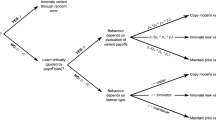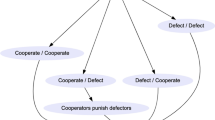Abstract
Most research on transmission biases in cultural evolution has treated different biases as distinct strategies. Here I present a model that combines both frequency dependent bias (including conformist bias) and payoff bias in a single decision-making calculus and show that such an integrated learning strategy may be superior to relying on either bias alone. Natural selection may operate on humans’ relative dependence on frequency and payoff information, but both are likely to contribute to the spread of variants with high payoffs. Importantly, the magnitude of conformist bias affects the evolutionary dynamics, and I show that an intermediate level of conformity may be most adaptive and may spontaneously evolve as it resists the invasion of low-payoff variants yet enables the fixation of high-payoff variants in the population.



Similar content being viewed by others
Code Availability
The graphical representations of all equations are created using python 3.7. The final agent-based simulation for the evolution of epistemic weights (shown in Fig. 3) is created using Julia 1.5.0. All codes are available at https://github.com/kevintoy/epistemic_weight_evo.
Notes
For example, suppose X1/X2, Y1/Y2, and Z1/Z2 denote different components of the same technology; for human populations to progressively achieve higher payoff, evolution needs to figure out the superior variant for each component and “lock onto it.” This process will be modeled later with an agent-based simulation approach.
These assumptions will also be relevant in the agent-based simulation discussed below.
The evolutionary dynamics shown in Fig. 1 resemble that of anticonformist transmission, though no conformity-related bias has been introduced. This is because the payoff component causes the population to evolve toward \(\frac{{b}_{1}}{\left({b}_{1}+{b}_{2}\right)}\), and thus the rare variant can increase in frequency.
Again, this result stems from the construction of Eq. 1 and may not hold for other formulations.
There has also been some discussion of negative D values (i.e., anticonformity). For example, see Denton et al. (2020).
Due to the way conformist bias is constructed here (as a single coefficient with maximum \(D=1\)), a variant sampled in \(\frac{{n}_{1}}{n}\) models, where \({n}_{1}>{n}_{2}\), can be adopted with a probability of at most \(\frac{{n}_{1}+1}{n}\). Thus, as \(n\) becomes large, the effect of conformity becomes weaker.
Realistically speaking, the time interval at which the new variant appears involves some random component, but in the present simulation a fixed interval is used because it does not qualitatively change the nature of the simulation and allows for better visual inspection of evolutionary trends.
Note that fitness was only incorporated in the agent-based simulation and not the first part of the model.
Though such cost is not incorporated in the present model.
References
Angelaki, D. E., Gu, Y., & DeAngelis, G. C. (2009). Multisensory integration: Psychophysics, neurophysiology, and computation. Current Opinion in Neurobiology, 19(4), 452–458. https://doi.org/10.1016/j.conb.2009.06.008
Baldini, R. (2012). Success-biased social learning: Cultural and evolutionary dynamics. Theoretical Population Biology, 82(3), 222–228. https://doi.org/10.1016/j.tpb.2012.06.005
Boyd, R., & Richerson, P. J. (1985). Culture and the evolutionary process. University of Chicago Press.
Boyd, R., & Richerson, P. J. (1995). Why does culture increase human adaptability? Ethology and Sociobiology, 16(2), 125–143. https://doi.org/10.1016/0162-3095(94)00073-G
Boyd, R., & Richerson, P. J. (2009). Voting with your feet: Payoff biased migration and the evolution of group beneficial behavior. Journal of Theoretical Biology, 257(2), 331–339. https://doi.org/10.1016/j.jtbi.2008.12.007
Boyd, R., & Richerson, P. P. J. (1996). Why culture is common, but cultural evolution is rare. Proceedings of the British Academy, 88, 77–93.
Creanza, N., Kolodny, O., & Feldman, M. W. (2017). Cultural evolutionary theory: How culture evolves and why it matters. Proceedings of the National Academy of Sciences (USA), 114(30), 7782–7789. https://doi.org/10.1073/pnas.1620732114
Day, T., & Bonduriansky, R. (2011). A unified approach to the evolutionary consequences of genetic and nongenetic inheritance. The American Naturalist, 178(2). https://doi.org/10.1086/660911.
Denton, K. K., Ram, Y., Liberman, U., & Feldman, M. W. (2020). Cultural evolution of conformity and anticonformity. Proceedings of the National Academy of Sciences (USA), 117(24), 13603–13614. https://doi.org/10.1073/pnas.2004102117
Derex, M., Bonnefon, J.-F., Boyd, R., & Mesoudi, A. (2019). Causal understanding is not necessary for the improvement of culturally evolving technology. Nature Human Behaviour, 3, 446–452. http://www.nature.com/articles/s41562-019-0567-9.
Edmonds, M. (2003). Stone tools and society: Working stone in Neolithic and Bronze Age Britain. Routledge. https://doi.org/10.4324/9780203481080.
Enquist, M., Eriksson, K., & Ghirlanda, S. (2007). Critical social learning: A solution to Rogers’s paradox of nonadaptive culture. American Anthropologist, 109(4), 727–734. https://doi.org/10.1525/aa.2007.109.4.727
Enquist, M., & Ghirlanda, S. (2007). Evolution of social learning does not explain the origin of human cumulative culture. Journal of Theoretical Biology, 246(1), 129–135.
Ewens, W. J. (2012). Mathematical population genetics: theoretical introduction, vol 1. Springer Science & Business Media.
Feldman, M., & Cavalli-Sforza, L. (1976). Cultural and biological evolutionary processes, selection for a trait under complex transmission. Theoretical Population Biology, 9(2), 238–259. https://doi.org/10.1016/0040-5809(76)90047-2
Frazer, J. G. (1890). The golden bough: A study in comparative religion. Macmillan.
Greenwood, J. D. (1999). Understanding the “cognitive revolution” in psychology. Journal of the History of the Behavioral Sciences, 35(1), 1–22. https://doi.org/10.1002/(SICI)1520-6696(199924)35:1%3c1::AID-JHBS1%3e3.0.CO;2-4
Henrich, J. (2001). Cultural transmission and the diffusion of innovations: Adoption dynamics indicate that biased cultural transmission is the predominate force in behavioral change. American Anthropologist, 103(4), 992–1013. https://doi.org/10.1525/aa.2001.103.4.992
Henrich, J. (2004). Demography and cultural evolution: how adaptive cultural processes can produce maladaptive losses—the Tasmanian case. American antiquity, 69(2), 197–214. https://doi.org/10.2307/4128416
Henrich, J. (2016). The secret of our success: How culture is driving human evolution, domesticating our species, and making us smarter. Princeton University Press.
Henrich, J., & Boyd, R. (1998). The evolution of conformist transmission and the emergence of between-group differences. Evolution and Human Behavior, 19(4), 215–241. https://doi.org/10.1016/S1090-5138(98)00018-X
Henrich, J., & Boyd, R. (2001). Why people punish defectors: Weak conformist transmission can stabilize costly enforcement of norms in cooperative dilemmas. Journal of Theoretical Biology, 208(1), 79–89. https://doi.org/10.1006/jtbi.2000.2202
Henrich, J., & Henrich, N. (2010). The evolution of cultural adaptations: Fijian food taboos protect against dangerous marine toxins. Proceedings of the Royal Society b: Biological Sciences, 277, 3715–3724. https://doi.org/10.1098/rspb.2010.1191
Henrich, J., & McElreath, R. (2003). The evolution of cultural evolution. Evolutionary Anthropology, 12(3), 123–135. https://doi.org/10.1002/evan.10110
Heyes, C. M. (1994). Social learning in animals: Categories and mechanisms. Biological Reviews of the Cambridge Philosophical Society, 69, 207–231. https://doi.org/10.1111/j.1469-185X.1994.tb01506.x
Hong, Z. (2022). Ghosts, divination, and magic among the Nuosu: An ethnographic examination from cognitive and cultural evolutionary perspectives. Human Nature, 33(4), in press.
Hong, Z. (2023). The cultural evolution of medical technologies: A model of sequential treatments in a medical setting. Human Nature, in press.
Hong, Z., & Henrich, J. (2021). The cultural evolution of epistemic practices. Human Nature, 32(3), 622–651. https://doi.org/10.1007/s12110-021-09408-6
Kayser, C., & Shams, L. (2015). Multisensory causal inference in the brain. PLoS Biology. https://doi.org/10.1371/journal.pbio.1002075
Kendal, J., Giraldeau, L. A., & Laland, K. (2009). The evolution of social learning rules: Payoff-biased and frequency-dependent biased transmission. Journal of Theoretical Biology, 260(2), 210–219. https://doi.org/10.1016/j.jtbi.2009.05.029
Kendal, R. L., Boogert, N. J., Rendell, L., Laland, K. N., Webster, M., & Jones, P. L. (2018). Social learning strategies: Bridge-building between fields. Trends in Cognitive Sciences. https://doi.org/10.1016/j.tics.2018.04.003
Laland, K. N. (2004). Social learning strategies. Animal Learning and Behavior, 32, 4–14. https://doi.org/10.3758/bf03196002
McElreath, R., Bell, A. V., Efferson, C., Lubell, M., Richerson, P. J., & Waring, T. (2008). Beyond existence and aiming outside the laboratory: estimating frequency-dependent and pay-off-biased social learning strategies. Philosophical Transactions of the Royal Society B: Biological Sciences, 363, 3515–3528. https://doi.org/10.1098/rstb.2008.0131
McElreath, R., Lubell, M., Richerson, P. J., Waring, T. M., Baum, W., Edsten, E., Efferson, C., & Paciotti, B. (2005). Applying evolutionary models to the laboratory study of social learning. Evolution and Human Behavior, 26(6), 438–508. https://doi.org/10.1016/j.evolhumbehav.2005.04.003
Meirmans, P. G. (2019). Hardy-Weinberg equilibrium. Encyclopedia of ecology (second edition), 3, 118-126. https://doi.org/10.1016/B978-0-12-409548-9.10555-X.
Mesoudi, A. (2005). The transmission and evolution of human culture. PhD thesis, University of St. Andrews.
Mesoudi, A. (2008). An experimental simulation of the “copy-successful-individuals” cultural learning strategy: Adaptive landscapes, producer-scrounger dynamics, and informational access costs. Evolution and Human Behavior, 29(5), 350–363. https://doi.org/10.1016/j.evolhumbehav.2008.04.005
Mesoudi, A., & O’Brien, M. J. (2008). The cultural transmission of Great Basin projectile-point technology I: An experimental simulation. American Antiquity, 73(1), 3–28. https://doi.org/10.1017/S0002731600041263
Miller, G. A. (2003). The cognitive revolution: A historical perspective. Trends in Cognitive Sciences, 7(3), P141-144. https://doi.org/10.1016/S1364-6613(03)00029-9
Morgan, T. J. H., Rendell, L. E., Ehn, M., Hoppitt, W., & Laland, K. N. (2012). The evolutionary basis of human social learning. Proceedings of the Royal Society B: Biological Sciences, 279(1729). https://doi.org/10.1098/rspb.2011.1172.
Muthukrishna, M., Morgan, T. J. H., & Henrich, J. (2016). The when and who of social learning and conformist transmission. Evolution and Human Behavior, 37(1), 10–20. https://doi.org/10.1016/j.evolhumbehav.2015.05.004
Nakahashi, W., Wakano, J. Y., & Henrich, J. (2012). Adaptive social learning strategies in temporally and spatially varying environments: how temporal vs. spatial variation, number of cultural traits, and costs of learning influence the evolution of conformist-biased transmission, payoff-biased transmission, and individual learning. Human Nature, 23, 386–418. https://doi.org/10.1007/s12110-012-9151-y
Nakao, H., & Machery, E. (2012). The evolution of punishment. Biology and Philosophy, 27, 833–850. https://doi.org/10.1007/s10539-012-9341-3
Pekala, R. J. (1991). The cognitive revolution in psychology. In Quantifying Consciousness: Emotions, Personality, and Psychotherapy (pp. 53–71). Springer. https://doi.org/10.1007/978-1-4899-0629-8_4.
Perreault, C., Moya, C., & Boyd, R. (2012). A Bayesian approach to the evolution of social learning. Evolution and Human Behavior, 33(5), 449–459. https://doi.org/10.1016/j.evolhumbehav.2011.12.007
Plotkin, H. C. (1988). The role of behavior in evolution. MIT Press.
Richerson, P. J. (2019). An integrated Bayesian theory of phenotypic flexibility. Behavioural Processes, 161, 54–64. https://doi.org/10.1016/j.beproc.2018.02.002
Richerson, P. J., & Boyd, R. (2005). Not by genes alone: How culture transformed human evolution. University of Chicago Press.
Schlag, K. H. (1998). Why imitate, and if so, how? Journal of Economic Theory, 78(1), 130–156. https://doi.org/10.1006/jeth.1997.2347
Sterelny, K. (2007). SNAFUS: An evolutionary perspective. Biological Theory, 2, 317–328. https://doi.org/10.1162/biot.2007.2.3.317
Thackray, A. (1970). Science and technology in the Industrial Revolution. History of Science, 9(1). https://doi.org/10.1177/007327537000900104.
Vale, G. L., Flynn, E. G., Kendal, J., Rawlings, B., Hopper, L. M., Schapiro, S. J., Lambeth, S. P., & Kendal, R. L. (2017). Testing differential use of payoff-biased social learning strategies in children and chimpanzees. Proceedings of the Royal Society B: Biological Sciences, 284(1868). https://doi.org/10.1098/rspb.2017.1751.
Whitehead, H., & Richerson, P. J. (2009). The evolution of conformist social learning can cause population collapse in realistically variable environments. Evolution and Human Behavior, 30(4), 261–273. https://doi.org/10.1016/j.evolhumbehav.2009.02.003
Acknowledgments
I thank Dr. Joseph Henrich for his continued encouragement and support for this project, and Peter Park and two anonymous reviewers for their very constructive feedback on earlier drafts of this manuscript.
Funding
Ze Hong was supported by a grant from the John Templeton Foundation and the Issachar Fund.
Author information
Authors and Affiliations
Corresponding author
Ethics declarations
Conflict of Interest
None.
Additional information
Publisher's Note
Springer Nature remains neutral with regard to jurisdictional claims in published maps and institutional affiliations.
Supplementary Information
Below is the link to the electronic supplementary material.
Rights and permissions
Springer Nature or its licensor (e.g. a society or other partner) holds exclusive rights to this article under a publishing agreement with the author(s) or other rightsholder(s); author self-archiving of the accepted manuscript version of this article is solely governed by the terms of such publishing agreement and applicable law.
About this article
Cite this article
Hong, Z. Combining Conformist and Payoff Bias in Cultural Evolution. Hum Nat 33, 463–484 (2022). https://doi.org/10.1007/s12110-022-09435-x
Accepted:
Published:
Issue Date:
DOI: https://doi.org/10.1007/s12110-022-09435-x




